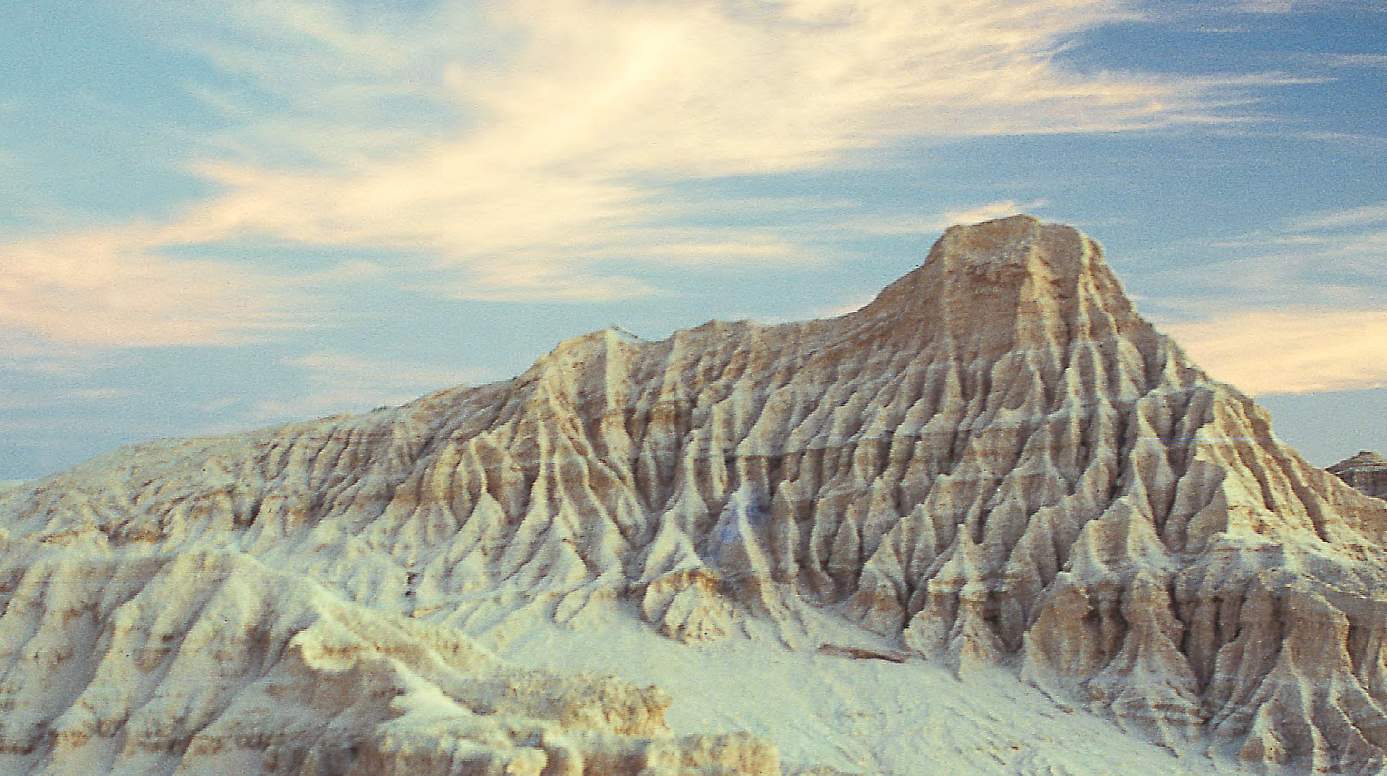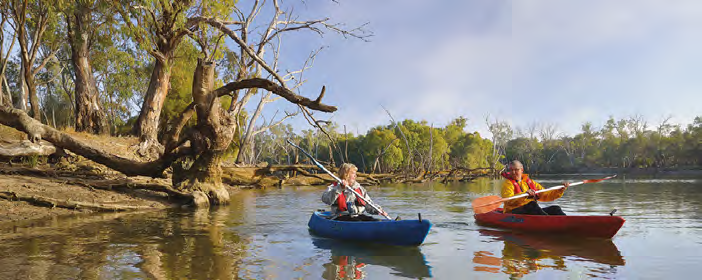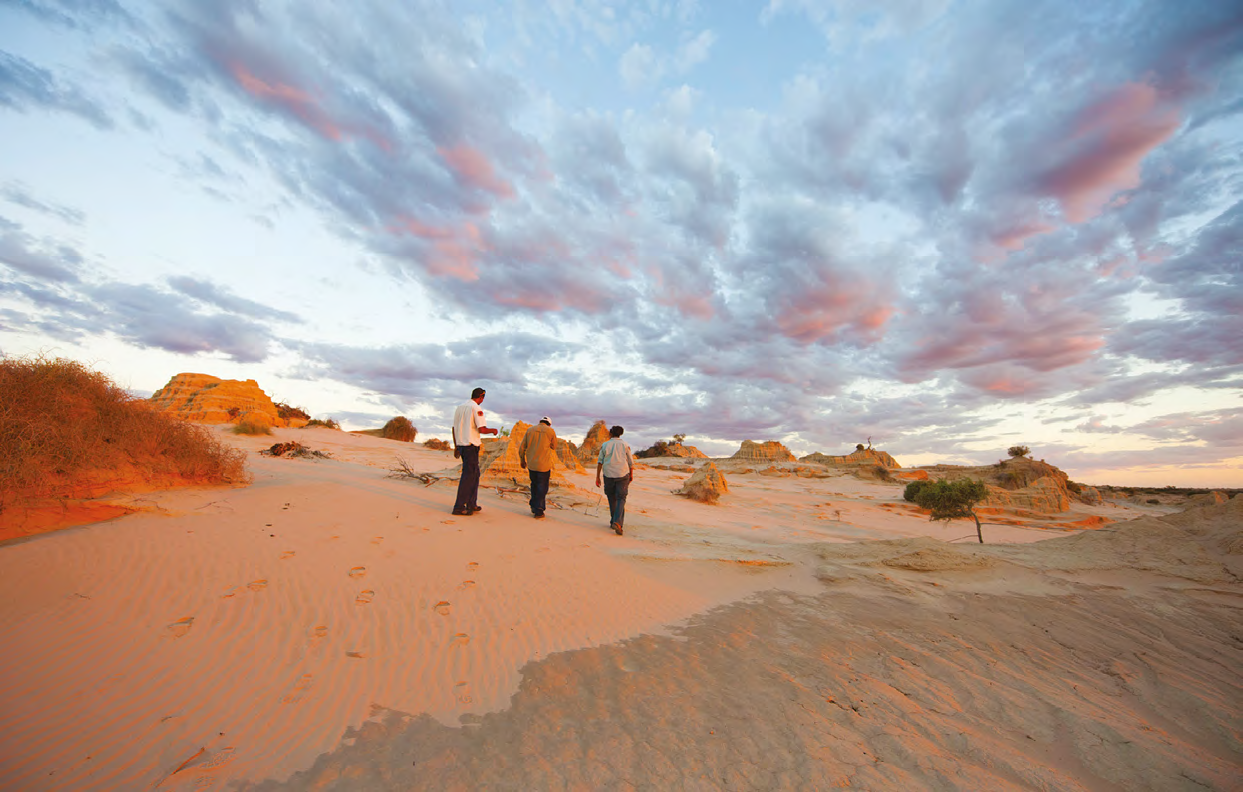
Walls of China, Mungo NP - G Bridle
Shake off the winter blues and escape the everyday with a trip to outback NSW. The cooler months of winter and early spring are a great time to hit the wide-open roads of western NSW and explore the rugged beauty of the national parks in this unique region.
Immerse yourself in the 40,000 year history of this dramatic region while exploring some of the world’s oldest and most remarkable rock art. Learn something new on an Aboriginal Discovery tour that will heighten your appreciation and understanding of this ancient landscape.
The superb seasonal wetlands make for spectacular birdwatching, and the inland rivers, the lifeline of the outback, are ideal for kayaking or a relaxing spot of fishing. Then as the light fades, experience the splendour of a desert sunset, before you kick back beneath a star-filled sky.

Snapshots, Mungo NP - Simon Hughes
JEWELS OF THE OUTBACK
With awe-inspiring landscapes, fascinating history, guided tours, walks and wildlife spotting, there are many reasons to put these national parks on your bucket list.
MUNGO NATIONAL PARK
Discover one of the most iconic outback landscapes in Mungo National Park, at the heart of NSW’s Willandra Lakes Region World Heritage Area, near Mildura. The Walls of China, rising from the ancient lake bed, sculpted by wind and water, are an unforgettable sight at sunset. Ironically, the erosion uncovered one of the most remarkable archaeological finds of the last century.
The discovery of Mungo Lady, the world’s oldest human cremations, and Mungo Man, led to the establishment of Mungo National Park. Estimated at more than 42,000 years old, these valuable ancient relics are of world significance, and highlight the enduring Aboriginal occupation of the region. This extraordinary region is of great significance to the Ngyiampaa, MutthiMutthi and Southern Paakantyi people.
To make the most of your visit to Mungo National Park, book a full day tour with Discover Mildura and receive a 15 percent discount. For outback NSW deals andoffers visit www.nationalparks.nsw.gov.au/outbackwanderer

Murrumbidgee River - Gavin Hansford
STURT NATIONAL PARK
Explore this fascinating region of the Corner Country, near Tibooburra. From the rolling red sand dunes to the flat-topped mesas and ancient granite tors, Sturt National Park is part of the traditional lands of the Wangkumara people. Steeped in a rich and varied history, highlights include the iconic dingo fence, Sturt’s Tree (accessible when the lake recedes) and the outdoor Pastoral Museum. All four campgrounds are equipped for motorhomes and trailers, and there’s also a range of historic accommodation.
At the heart of this desert park is Lake Pinnaroo, an internationally recognised seasonal wetland that plays a crucial role in the survival of a vast array of waterbirds, waders and migratory species. If you’re here after the rains, be sure to keep an eye out for the threatened freckled duck and blue-billed duck.
YANGA NATIONAL PARK
On the banks of the Murrumbidgee near Balranald, Yanga National Park is a must-see for wildlife and birdwatching enthusiasts. From the fertile floodplains and waterways, where the mighty river red gums thrive, to the sweeping desert landscape of saltbush and native grass lands, Yanga National Park safeguards a fascinating array of natural wonders. With 170km of river frontage, kayaking is a great way to experience this unique park and the diverse range of wildlife, Aboriginal and pastoral history within it.
Retrace the steps of early explorers, take a self-guided tour of Yanga Woolshed or simply enjoy a spot of fishing under the shade. From the lakeside Yanga Red Gum bird hide you might see egrets, spoonbills and glossy ibis foraging in the tranquil waters.

Willandra wanderings - Simon Hughes
PLANNING YOUR OUTBACK ADVENTURE
It’s never been easier to plan your outback adventure. NSW National Parks has put together a range of easy to follow itineraries and self-drive tours that showcase the best on offer in this amazing region. Best of all, they’ve been designed to suit campervan and motorhome enthusiasts.
The itineraries have been designed by the local experts offering suggested driving routes, scenic stopovers, Aboriginal Discovery tours, guided walks, and camping spots, as well as access to a range of great deals from local tour operators.
Ideally suited for self-reliant travellers, choose from a range of two to five-day tours, leading deep into the dusty heart of the outback. Grouped by region, these driving tours take in several national parks at a time, offering you flexibility to create your own outback adventure.

Yanga Homestead - Gavin Hansford
BROKEN HILL AND BEYOND – OUTBACK DISCOVERY
This fascinating drive begins in the classic outback town of Broken Hill, 1200km west of Sydney. It’s a tasting plate of what’s on offer out west: rugged rock formations, world renowned Aboriginal art plus wetlands and floodplains offering unforgettable birdwatching.
This drive leads you north-east to Mutawintji National Park and the everchanging colours of the Bynguano Ranges where you can experience some of the most culturally significant rock art in Australia at the Mutawintji Historic Site.
To the east is the magnificent Menindee Lake system, in Kinchega National Park. Brimming with life, these freshwater wetlands offer some spectacular birdwatching.
Co-management of this park, with the Menindee Aboriginal Elders Council, has resulted in protecting and managing many significant sites, and an Aboriginal Discovery tour is a great way to delve into the living history of this region. Relive the pastoral history of this challenging landscape with a visit to the Kinchega Woolshed and Homestead.
Heading west past Wilcannia, experience the sweeping river floodplains and thriving wetlands of Paroo-Darling National Park. Drop into the visitors centre to book on an Aboriginal Discovery tour and discover how the surrounding red hills and Darling River floodplains sustained the Ngiyeempaa and Paakantyi people through the seasonal extremes.

Murrumbidgee Valley, Yanga NP - Boris Hlavica
THE MURRAY RIVER AND MIGHTY MUNGO – THE LONG PADDOCK
Immerse yourself in majestic riverside scenery, striking outback landscapes and the rich Aboriginal and pastoral heritage of the Murray-Riverina area. This journey showcases the huge diversity of the NSW outback – from the world’s largest tract of river red gum forest to the iconic Walls of China in Mungo National Park.
First port of call is Murray Valley National Park, near Deniliquin, where you can explore the tranquil gum-lined Murray River and Ramsar-listed wetlands. Ideal for birdwatching, fishing and canoeing, this park protects part of the largest continuous red gum forest in the world and more than 60 threatened native animal species call it home.
You’ll then head north-west towards Balranald to Yanga National Park.
Explore the century-old Yanga Woolshed, take a guided tour of the historic Yanga Homestead or simply set up camp on the banks of Yanga Lake and watch the antics of the local wildlife.
From here you’ll head towards Mungo National Park in the heart of the Willandra Lakes World Heritage Area. Wander the sands of time in this vast ancient landscape. With suggested walks, driving tours and picnic spots along the way, be sure to head back to see the Walls of China at sunset: an unforgettable sight.
Visit www.nationalparks.nsw.gov.au/outbackwanderer for a full list of suggested drives and itineraries.

Yanga day use - D Finnegan
SAFETY TIPS FOR YOUR OUTBACK TRIP
To ensure you’re well prepared for your outback adventure, follow these safety tips.

Claypan, Sturt NP - John Gerritson
Category: Features
Written: Wed 01 July 2015
Printed: July, 2015
Published By: